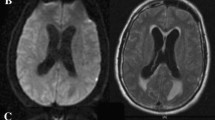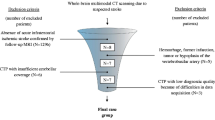Abstract
Objective
To investigate magnetic resonance imaging (MRI) detection of cerebral infarction (CI) in patients presenting with subarachnoid hemorrhage (SAH).
Background
CI is a well-known complication of SAH that is typically detected on computed tomography (CT). MRI has improved sensitivity for acute CI over CT, particularly with multiple, small, or asymptomatic lesions.
Methods
With IRB approval, 400 consecutive SAH patients admitted to our institution from August 2006 to March 2011 were retrospectively reviewed. Traumatic SAH and secondary SAH were excluded. Data were collected on demographics, cause of SAH, Hunt Hess and World Federation of Neurosurgical Societies grades, and neuroimaging results. MRIs were categorized by CI pattern as single cortical (SC), single deep (SD), multiple cortical (MC), multiple deep (MD), and multiple cortical and deep (MCD).
Results
Among 123 (30.8 %) SAH patients who underwent MRIs during their hospitalization, 64 (52 %) demonstrated acute CI. The mean time from hospital admission to MRI was 5.7 days (range 0–29 days). Among the 64 patients with MRI infarcts, MRI CI pattern was as follows: MC in 20 (31 %), MCD in 18 (28 %), SC in 16 (25 %), SD in 3 (5 %), MD in 2 (3 %), and 5 (8 %) did not have images available for review. Most infarcts detected on MRI (39/64 or 61 %) were not visible on CT.
Conclusions
The use of MRI increases the detection of CI in SAH. Unlike CT studies, MRI-detected CI in SAH tends to involve multiple vascular territories. Studies that rely on CT may underestimate the burden of CI after SAH.




Similar content being viewed by others
References
Rosengart AJ, Schultheiss KE, Tolentino J, Macdonald RL. Prognostic factors for outcome in patients with aneurysmal subarachnoid hemorrhage. Stroke. 2007;38:2315–21.
Vergouwen MDI, Ilodigwe D, Macdonald RL. Cerebral infarction after subarachnoid hemorrhage contributes to poor outcome by vasospasm-dependent and -independent effects. Stroke. 2011;42:924–9.
Fergusen S, Macdonald RL. Predictors of cerebral infarction in patients with aneursymal subarachnoid hemorrhage. Neurosurgery. 2007;60:658–67.
Rabinstein AA, Weigand S, Atkinson JLD, Wijdicks EF. Patterns of cerebral infarction in aneurysmal subarachnoid hemorrhage. Stroke. 2005;36:992–7.
Temes RE, Tessitore E, Schmidt JM, et al. Left ventricular dysfunction and cerebral infarction from vasospasm after subarachnoid hemorrhage. Neurocrit Care. 2010;13:359–65.
Kilbourn KJ, Levy S, Staff I, Kureshi I, McCullough L. Clinical characteristics and outcomes of neurogenic stress cardiomyopathy in aneurysmal subarachnoid hemorrhage. Clin Neurol Neurosurg. 2013;115:909–14.
Vergouwen MD, Vermeulen M, Coert BA, Stroes ES, Roos YB. Microthrombosis after aneurismal subarachnoid hemorrhage: an additional explanation for delayed cerebral ischemia. J Cereb Blood Flow Metab. 2008;28:1761–70.
Stein SC, Browne KD, Chen XH, Smith DH, Graham DI. Thromboembolism and delayed cerebral ischemia after subarachnoid hemorrhage: an autopsy study. Neurosurgery. 2006;59(4):781–7.
Dreier JP, Woitzik J, Fabricius M, et al. Delayed ischaemic neurological deficits after subarachnoid haemorrhage are associated with clusters of spreading depolarizations. Brain. 2006;129:3224–37.
Wagner M, Steinbes P, Güresir E, et al. Beyond delayed cerebral vasospasm: infarct patterns in patients with subarachnoid hemorrhage. Clin Neuroradiol. 2013;23:87–95.
Hijdra A, Van Gijn J, Stefanko S, Van Dongen KJ, Vermeulen M, Van Crevel H. Delayed cerebral ischemia after aneurysmal subarachnoid hemorrhage: clinicoanatomic correlations. Neurology. 1986;36:329–33.
Vergouwen MD, Vermeulen M, van Gijn J, et al. Definition of delayed cerebral ischemia after aneurysmal subarachnoid hemorrhage as an outcome event in clinical trials and observational studies: proposal of a multidisciplinary research group. Stroke. 2010;41(10):2391–5.
Crowley RW, Medel R, Dumont AS, et al. Angiographic vasospasm is strongly correlated with cerebral infarction after subarachnoid hemorrhage. Stroke. 2011;42:919–23.
Rabinstein AA, Friedman JA, Weigand SD, et al. Predictors of cerebral infarction in aneurysmal subarachnoid hemorrhage. Stroke. 2004;35(8):1862–6.
Naidech AM, Bendok BR, Bassin SL, Bernstein RA, Batjer HH, Bleck TP. Classification of cerebral infarction after subarachnoid hemorrhage impacts outcome. Neurosurgery. 2009;64(6):1052–7.
Frontera JA, Fernandez A, Schmidt JM, et al. Defining vasospasm after subarachnoid hemorrhage: what is the most clinically relevant definition? Stroke. 2009;40:1963–8.
Macdonald RL, Kassell NF, Mayer S, et al. Clazosentan to overcome neurological ischemia and infarction occurring after subarachnoid hemorrhage (CONSCIOUS-1): randomized, double-blind, placebo-controlled phase 2 dose-finding trial. Stroke. 2008;39:3015–21.
Forssell A, Larsson C, Ronnberg J, Fodstad H. CT assessment of subarachnoid haemorrhage: a comparison between different CT methods of grading subarachnoid haemorrhage. Br J Neurosurg. 1995;9:21–7.
De Rooij NK, Frijns CJ, Velthuis BK, Rinkel GJ. Secondary infarction in single or in multiple vascular territories: two different entities following subarachnoid hemorrhage? J Neurol. 2011;258:2133–9.
Hadeishi H, Suzuki A, Yasui N, Hatazawa J, Shimosegawa E. Diffusion-weighted magnetic resonance imaging in patients with subarachnoid hemorrhage. Neurosurgery. 2002;50:741–8.
Wartenberg KE, Sheth SJ, Schmidt MJ, et al. Acute ischemic injury on diffusion-weighted magnetic resonance imaging after poor grade subarachnoid hemorrhage. Neurocrit Care. 2011;14(3):407–15.
Shimoda M, Takeuchi M, Tominaga J, Oda S, Kumasaka A, Tsugane R. Asymptomatic versus symptomatic infarcts from vasospasm in patients with subarachnoid hemorrhage: serial magnetic resonance imaging. Neurosurgery. 2001;49:1341–50.
Kramer AH, Mikolaenko I, Deis N, et al. Intraventricular hemorrhage volume predicts poor outcomes but not delayed ischemic neurological deficits among patients with ruptured cerebral aneurysms. Neurosurgery. 2010;67(4):1044–53.
Gross BA, Lin N, Rerichs KU, Du R. Vasospasm after spontaneous angiographically negative subarachnoid hemorrhage. Acta Neurochir. 2012;154:1127–33.
Kumar A, Brown R, Dhar R, et al. Early vs. delayed cerebral infarction after aneurysm repair after subarachnoid hemorrhage. Neurosurgery. 2013;74:617–23.
Hoh BL, Topcuoglu MA, Singhal AB, et al. Effect of clipping, craniotomy, or intravascular coiling on cerebral vasospasm and patient outcome after aneurysmal subarachnoid hemorrhage. Neurosurgery. 2004;55:779–89.
Koivisto T, Vanninen R, Hurskainen H, Saari T, Hernesniemi J, Vapalahti M. Outcomes of early endovascular versus surgical treatment of ruptured cerebral aneurysms: a prospective randomized study. Stroke. 2000;31:2369–77.
Rabinstein AA, Pichelmann MA, Friedman JA, et al. Symptomatic vasospasm and outcomes following aneurysmal subarachnoid hemorrhage: a comparison between surgical repair and endovascular coil occlusion. J Neurosurg. 2003;98:319–25.
Cronqvist M, Wirestam R, Ramgren B, et al. Diffusion and perfusion MRI in patients with ruptured and unruptured intracranial aneurysms treated by endovascular coiling: complications, procedural results MR findings and clinical outcome. Neuroradiology. 2005;47:855–73.
Soeda A, Sakai N, Sakai H, et al. Thromboembolic events associated with Guglielmi detachable coil embolization of asymptomatic cerebral aneurysms: evaluation of 66 consecutive cases with use of diffusion-weighted MR imaging. AJNR Am J Neuroradiol. 2003;24:127–32.
Rordorf G, Bellon RJ, Budzik RE, et al. Silent thromboembolic events associated with the treatment of unruptured cerebral aneurysms by use of Guglielmi detachable coils: prospective study applying diffusion-weighted imaging. AJNR Am J Neuroradiol. 2001;22:5–10.
Vermeer SE, Longstreth WT Jr, Koudstaal PJ. Silent brain infarcts: a systematic review. Lancet Neurol. 2007;6:611–9.
Vergouwen MD, Etminan N, Ilodigwe D, Macdonald RL. Lower incidence of cerebral infarction correlates with improved functional outcome after aneurysmal subarachnoid hemorrhage. J Cereb Blood Flow Metab. 2011;31:1545–53.
Schmidt JM, Rincon F, Fernandez A, et al. Cerebral infarction associated with acute subarachnoid hemorrhage. Neurocrit Care. 2004;7:10–7.
Shimoda M, Hoshikawa K, Shiramizu H, et al. Early infarction detection by diffusion-weighted imaging in patients with subarachnoid hemorrhage. Acta Neurochir. 2010;52:1197–205.
Sato K, Shimizu H, Fujimura M, Inoue T, Matsumoto Y, Tominaga T. Acute-stage diffusion-weighted magnetic resonance imaging for predicting outcome of poor-grade aneurysmal subarachnoid hemorrhage. J Cereb Blood Flow Metab. 2010;30:1110–20.
Frontera JA, Ahmed W, Zach V, et al. Acute ischaemia after subarachnoid hemorrhage, relationship with early brain injury and impact on outcome: a prospective quantitative MRI study. J Neurol Neurosurg Psychiatry. 2015;86(1):71–8.
Author information
Authors and Affiliations
Corresponding author
Rights and permissions
About this article
Cite this article
Korbakis, G., Prabhakaran, S., John, S. et al. MRI Detection of Cerebral Infarction in Subarachnoid Hemorrhage. Neurocrit Care 24, 428–435 (2016). https://doi.org/10.1007/s12028-015-0212-z
Published:
Issue Date:
DOI: https://doi.org/10.1007/s12028-015-0212-z




